
The Wild South: Bron’s Guide to Dublin and Southern Ireland
There are places in the world which bring a smile to my face and a little thrill when words like ‘you’re going to Ireland’ flash up on the screen when making bookings... and Ireland is one of those places.
Ireland is easy. The kind of place where pubs line the streets you walk down, the jolly sound of rambunctious laughter forcing its way past the windows and doors, flooding into the street like light. The attention-grabbing hint of Guinness in the air the moment you step inside. The loudness of the place – in every way that’s good.
Ireland doesn’t want to go quietly into the night. She wants to be noticed, loved, adored, remembered... and she does it well, if I do say so myself.
The cities themselves ignite a burning curiosity whenever mentioned. Take Dublin, for instance. I’m not Irish myself, but I cannot help but attempt to say the name in the local accent. Doob-lin. Though my accent leaves something to be desired, it still brings to the surface a little giggle.
This is how I was, at least, in the days leading up to my adventure into Ireland. Giddy.
I was heading to Dublin – and then on to explore the southern tip of Ireland. What waited for me were things out of a fantasy world. A rugged and untamed wildness, like the screeching of an unseen bird from the thick canopy of the dark forest looming above you.
And I’m not just talking about the wild landscapes of Ireland, the kind of places were ferocious ocean waters strike like hammer on drum against rock faces so ancient. I’m also talking about the parts of Ireland that you won’t see as landscapes in some of your favourite movies (think Star Wars and The Princess Bride) - I’m talking about the cities. Where locals, ex-pats, and travellers congregate into a chaotic mix of energies and accents, bringing their own individuality to the cobbled streets of a city with a fascinating history. Because Ireland’s not new to the game of history, and even her cities – like Dublin – have a lot to say about their time with us on this planet.
So, it was a privilege and thrill to meet Dublin earlier this year. She’s a gateway city, to be sure, and from her very doorstep I saw parts of Ireland I’d only ever seen on the big screen, or daydreamed about, or were on my travel bucket list.
If you’re planning a trip to the south of Ireland (or any part of it, to be fair), then Dublin is a great hub from which to explore this alluring part of the world.
Coming up in this blog:
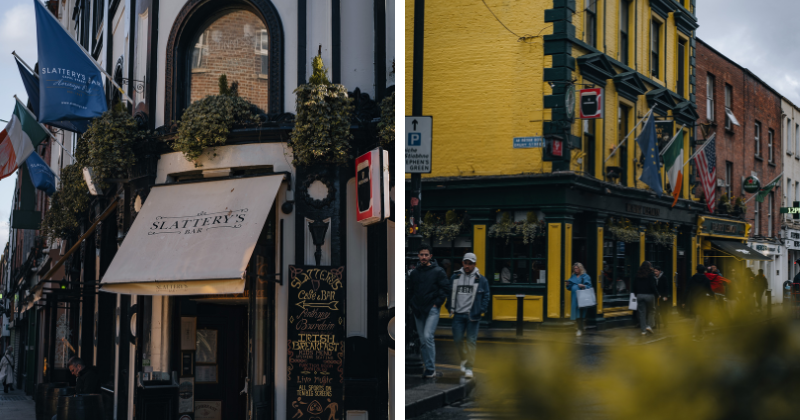
Things to Eat in Dublin (and Ireland)
Dublin is the kind of place that’s as intimate as a village but with endless things to do, the kind of place where you might run into a friend at one of its many pubs. Speaking of pubs, there’s an incredible concentration of them in Dublin – not to mention the astounding array of other culture’s cuisines among cafes and restaurants.
So, no matter what calls to the heart in your stomach, you’ll find it in Dublin.
In saying that... you’re in Ireland, mucker (Irish slang for ‘pal’), and a huge part of any travel experience is in the food and drink.
The drinking part is easy... simply find a pub and order yourself a pint of Guinness or a shot of whiskey, and you’re golden. Or Irish green, whichever makes more sense. And you’re on holiday, so having multiple of each drink every day is absolutely acceptable. There’s no judging in Ireland.
However, if you’re a non-drinker like me, you may just have to rely on an Irish culinary experience... which sounded pretty good to me (and my stomach).
Soda Bread
Soda bread will be different everywhere you go. Maybe it will be made sweet with honey, sugar, or dried fruits. Perhaps it will be sprinkled with seeds or mixed with oats... or even with Guinness. The point is that soda bread is a staple in every Irish household and if you’re going to have the true Irish experience, you should add ‘try soda bread from local bakery’ to your must-do list.
Irish Stew
We love a simple meal, especially ones that don’t require too much cleanup afterwards. That’s Irish Stew – a rich and hearty meal traditionally made with mutton, onions, and potatoes. Especially on a cold Irish day, a bowl of Irish Stew can recharge you over lunch and get you ready for the rest of the day. Easiest place to find this (apart from making a friend and inviting yourself over) is to head to a traditional Irish pub and hope it’s on the menu!
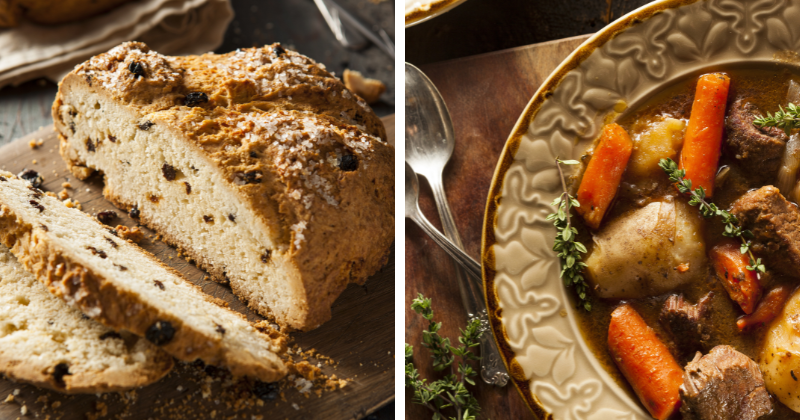
Boxty
This was hands down one of my favourite local dishes – because anything that combines the word potato with dumpling or pancake or bread... well, that’s fine by me. And while some say the name originates from an Irish phrase meaning ‘poor-house bread’ (arán bocht tí), I think it’s safe to say that potatoes are a worldwide favourite and no-one has to twist my arm in order to get me to try something made from this starchy goodness.
The recipe mixes grated raw potato with mashed potato – and, after that, there are several ways for it to be prepared, all of which involve batter or butter and frying so... any way it’s prepared sounds fine by me.
Barmbrack
Fruit loaf is a go-to for me. Give me bread filled with fruit and smothered with butter (and a cup of tea on the side) any day of the year. Keep an eye out at bakeries for this local goodie, which is baked with raisins, candied peel, and a mix of spices. What I love is that the candied peel is sometimes left overnight to soak in black tea and whiskey, which is just so... Irish.
Centra
This one was recommended to me personally by a friend of mine. Centra may be Ireland’s most popular grocery convenience store chain, but inside each you’ll find a hot food station frequented at lunchtime serving all manner of delicious goodies. The chicken, in particular, I was told was a staple of Ireland... so of course I had to partake. And if you’re looking for something cheap and cheerful and quick (not to mention powerfully tasty), then pop into a Centra while you’re in Dublin – trust me, they’re everywhere.
I could go on and on about the things you must try in Ireland... Seafood Chowder, Boiled Cabbage and Bacon, Colcannon. You can take a look at our longer list here. Just promise me you’ll be brave – try something new, step outside your foodie comfort zone, and I’m certain you’ll find something you love.
Things to Do in Dublin
Christ Church Cathedral
First on my list was something that often makes a Dublin itinerary because sometimes you can’t go past a good cathedral. Personally, I adore a good cathedral. The dramatic way the towers loom over me, the unfathomably intricate windows and carvings, how walking down the centre of the nave is humbling every single time no matter which cathedral you’re in, how old it is or why it was built... the same feelings apply. Awe and inspiration.
And Christ Church Cathedral is no exception. It’s been a place of pilgrimage for around 1,000 years and is renowned for its striking architecture and exquisite flooring inside. People know to look up when they enter a cathedral, but make sure you also look down. The bright colours and geometric patterns, beautiful symbols and haunting figures... some of the tiles are original and date back to the medieval period.
The cathedral was founded back in 1030 by Sitric, King of the Dublin Norsemen. No idea who they were? Well, back when Vikings invaded the land back in the 9th century, the Kingdom of Dublin was established. This Norse kingdom was the first and longest lasting one to have existed in Ireland.
Personally, I’m obsessed with anything creepy and haunted... or at least that’s how it feels entering a 12th century crypt. And within the cathedral lies the oldest and largest crypt in Ireland and Britain. So, if you get a thrill out of the slightly macabre like me, this is your stop.
I think my favourite part though was the sculpture in the courtyard of the cathedral. Hiding in the grand structure’s shadow lies Homeless Jesus, a work completed by Canadian sculptor Tim Schmalz to draw attention to the plight of homelessness in the city. Cast in bronze, the sculpture is of a man – Jesus – lying on a park bench hidden beneath blankets. It was both haunting and beautiful, a quiet place of reflection that honestly did make me stop in my tracks.
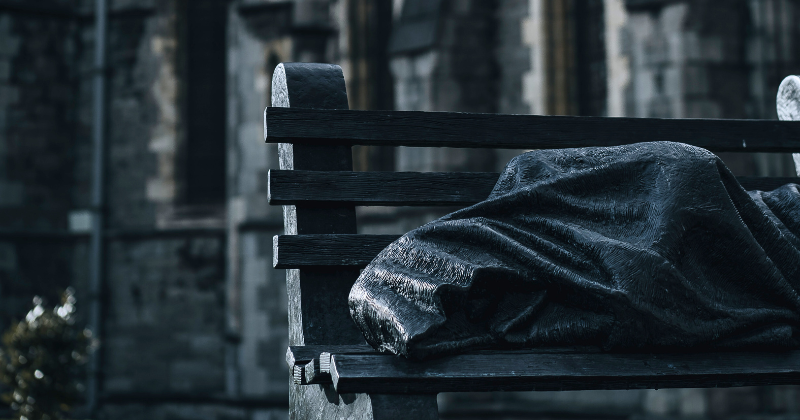
Marsh’s Library
This was one I stumbled upon when surfing the internet one day and once my attention had been drawn to the beauty of Marsh’s Library, I knew I had to visit. Located just beside St Patrick’s Cathedral, this stunningly preserved library is well worth your time. It's a dark and quiet place, yet the spines of these ancient tomes almost glisten like jewels in a cave. Old, detailed wooden bookshelves line the walkway like slumbering giants, and there's almost too much to take in.
Sponsored and built with money provided by Archbishop Narcissus Marsh, a man known for his academics and love of books and learning, it’s a library showcasing ‘early Enlightenment’, an intellectual movement from the 17th and 18th centuries that promoted the ideas of God, reason, nature, and humanity. It was the first public library in Ireland that wasn’t found inside a university or church and was intended as a place where anyone could come to study (assuming they knew how to read, of course).
The library was a great success, and many came to study here. But the beauty of the books was so alluring to some that theft became a big problem and by the mid-1760s, there were over 1000 books missing. Rules were set in place to restrict visitor’s movements, including locking people in ‘reading cages’ while they were visiting.
Apparently, Bram Stoker, the Irish author of Dracula, came to read at the library in 1866. And thanks to detailed records, we know which books he read... and is anyone surprised to hear that he looked at travel books depicting maps of Transylvania?
And for me? I was there for the books. I wasn’t really fussed with their content; I was simply obsessed with their beauty. As I meandered down the aisles, breathing in an atmosphere of dusty tomes and ancient history, I was filled with disappointment that we don’t make books like this anymore. Each one was a leather-bound work of art. Can you imagine the cost of attempting it?
But it wasn’t just the books and manuscripts that hooked my attention. The library was filled with ancient and gorgeous maps, so weathered and old, it made me long for the days when effort was put into things like maps and books. When they were more than simply a tool to be used or a good gift to buy a friend... they were works of art.
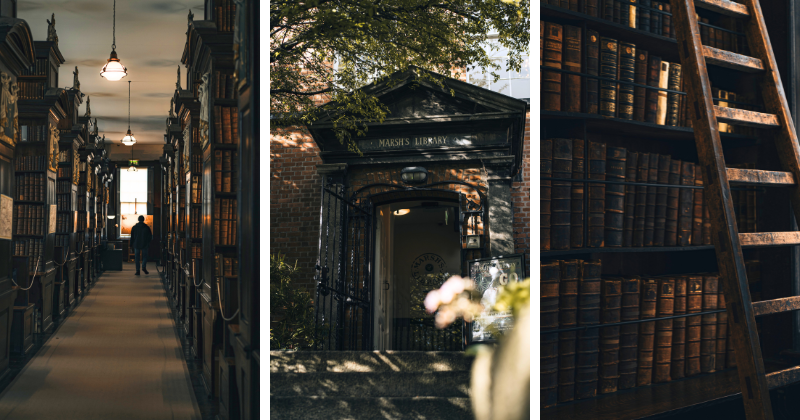
Temple Bar
It’s simple. You can’t visit Dublin and not at least lay eyes on the Temple Bar. If you’re looking for a night out, this is the place. This legendary venue has live Irish music from open to close, 7 days a week, and is the perfect spot to join your friends for a drink, being home to Ireland’s largest whiskey collection, a drool-worthy selection of Irish beers and scrumptious food. One fact I love is that in 2011 it achieved the Guinness World Record for longest marathon playing guitar set by David Browne: 1114 hours, 6 minutes and 30 seconds. Ooft.
And the vibe! It’s the place to be on St. Paddy’s Day – or any day. Colourful and packed full of trinkets. Neon lights on the wall beside old picture frames. Flags overhead and a wall of glistening bottles packed with iconic spirits and flavours. It’s the kind of place you walk by and it’s a vibrant hub of energy and fun and good-natured Irish spirit that’s been welcoming visitors since 1840.
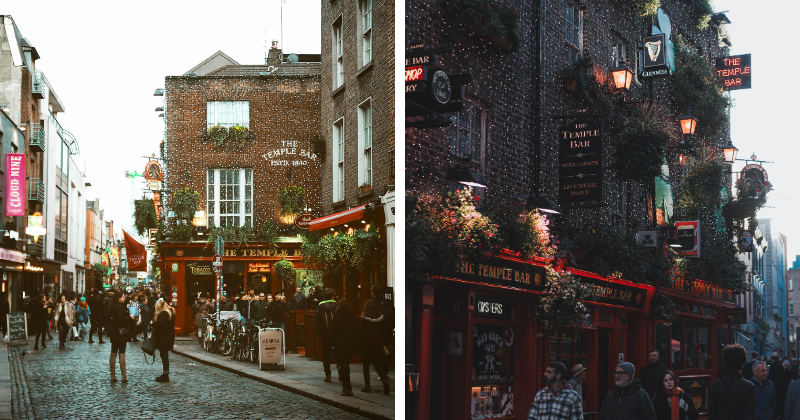
Guinness Storehouse
What is a visit to Ireland without sampling some Guinness? Well, as a non-drinker, I can tell you that even without sampling the dark, thick, rich drink the Irish are so proud of, you still need to at least see the Storehouse for yourself.
Ireland’s landscape might very well be the heart of Ireland, but Guinness is the gut. Or that’s where it sits. Either way... Guinness is Ireland. It’s hearty, it’s bold, it packs a punch, and it’s hard to forget. Just like Ireland.
There are seven floors to explore at the Guinness Storehouse building. It’s the perfect place to indulge in your love of Guinness, Ireland, drinking... all that good stuff. It was humorous to me how many people were arriving and departing in taxis – makes sense. Even the local tourism quirks had caught on, with horses and carriages passing by, ferrying visitors to and from this gigantic building. It was a clashing of two worlds – the modernity of the Storehouse and the natural beauty of the horses, all coming together in one strange mix. Kind of like Guinness.
The Storehouse is more than a museum, it’s almost a theme park with plenty of activities to keep you entertained. Maybe you’ll opt for experiencing the Guinness STOUTie, a pint of Guinness with your own selfie printed onto the head. Or pouring your own pint at the Guinness Academy. At the very least, head to the Gravity Bar for a 360-degree view of Dublin.
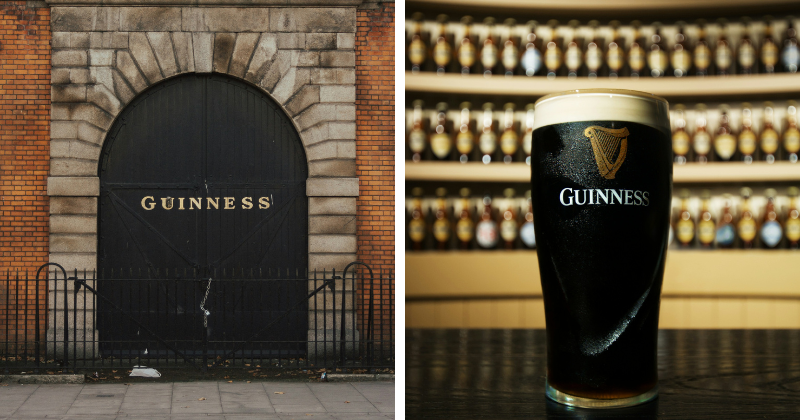
EPIC The Irish Emigration Museum
If you’re a fan of museums, but want something that packs a little more punch, head to EPIC The Irish Emigration Museum. There are twenty interactive galleries here. That’s right, twenty. It’s a different side of Ireland – it's not about the landscapes or the Guinness. It’s not the jolliness of the local pub or the fresh air pulsating around you as you gaze out over an emerald view, but here you’ll discover another part of what it means to be Irish even beyond the borders of Ireland itself.
These are the stories of the Irish emigrants who left their home to become scientists, politicians, poets, artists, and even outlaws all over the world. Why did they leave? Where did they go? What did they do? These are the questions that will be answered. It’s a fascinating look at the history of Ireland from a different lense, and you can even discover your own Irish ancestry through the Irish Family History Centre (IFHC) located within the museum. Because let’s be honest... we’re all a little bit Irish, even in spirit, right?
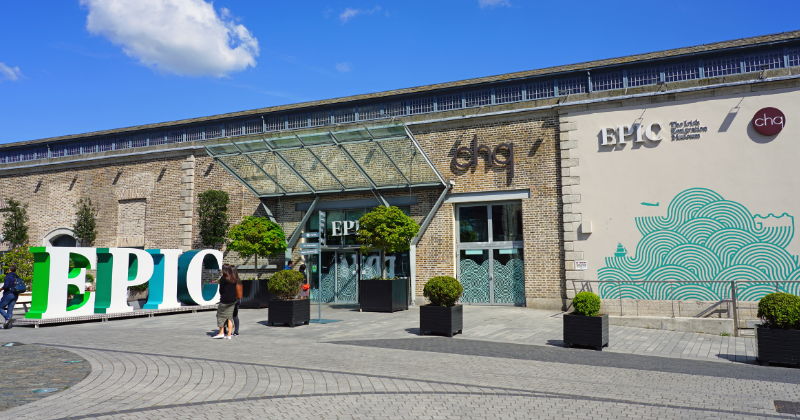
Dublin Castle
And what would a visit to Ireland – even an Irish city – be without a castle? Because, let’s be honest, we all love a good castle. Castles have a way of making us feel both humbled and thrilled at the same time. We itch to know the history, to be the ones to discover something no one else has, to maybe accidentally get sucked back in time (I’m aware this isn’t Outlander or Scotland, but I’ll try my luck wherever I can), and to experience – just for a moment – something spectacular. Something beyond the modernity we’re smothered with day after day. To slow down and allow ourselves to be consumed by history, even if just for an hour or two.
Enter Dublin Castle. It sits snuggly on the ancient site of a Danish Viking fortress from 930AD. The first stone was cast by King John of England back in 1230 and remained under British rule until 1921. A beautiful mix of medieval and Viking structures, the most striking part has to be the Medieval Tower. It's one of the oldest (and most important) parts of the city of Dublin that still stands today. It was built some time around 1204-28, constructed during the reign of Henry III (1207-72).
Dublin Castle itself is known as one of the most important buildings in Irish history and in its long life, it’s been a court, a fortress, a site of execution (gulp). I can only imagine the things it’s been witness to over the years. Part of me is curious and part of me is glad to leave the past in the past.
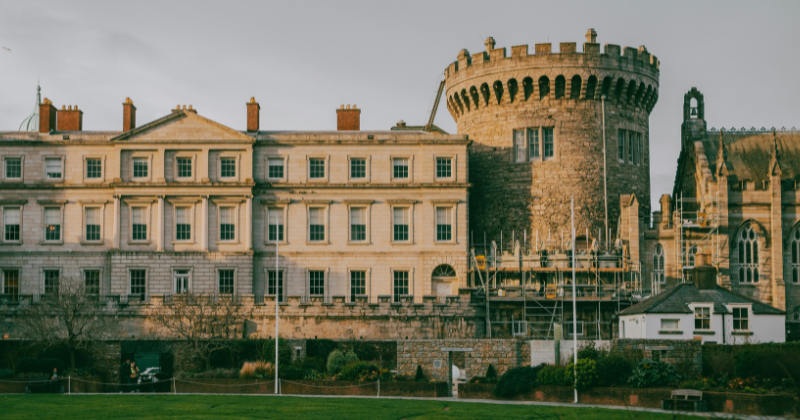
Jameson Distillery Bow St.
Another Irish staple: whiskey. If a memorable kick is what you like in a drink, then whiskey is the one for you and where better to try it than in a country like Ireland? Whiskey lovers around the world are quite familiar with the Jameson brand. Back in 1780, John Jameson welcomed visitors to his new distillery on Bow St and more than 200 years later, those doors are still open.
It was a vibrant place – trendy and modern but trimmed with an old school feel. Not just in its design – but in its feeling... a head-nod to the days when friends would gather at the local pub and have a chinwag over a glass of whiskey. And we know that tradition is not dead, but something about this former factory felt like more than just a monument to Irish Whiskey, it was a monument to a slower pace of life.
Bottles of whiskey glistened like gold-stained walls; laughter thrummed around me as drinks were poured, precious gold into wee glasses, a buzz that only the combination of alcohol and good friendship can produce, and it seemed to me the perfect place to end up at the end of a day of exploration.
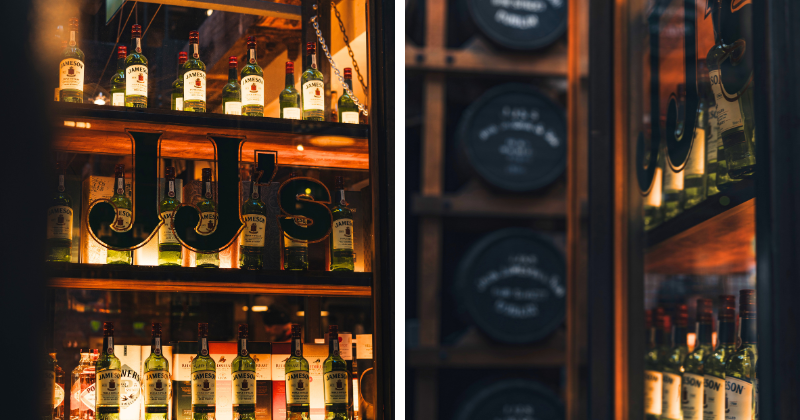
Day Trips from Dublin
Kilbeggan Distillery
If Bow St’s distillery wasn’t quite enough (or you’re seeking more of that good-natured spirit), there’s only one thing left for you to do: visit another distillery.
After exploring Dublin, I hopped onto Rabbie's 5-day Escape to the South-West tour, and first up was a visit to Kilbeggan Distillery. Now, keep in mind that in Ireland, alcohol cannot be served or sold on Sunday mornings and when we visited, not only was it a Sunday, but it was Easter Sunday. Still, as a non-drinker this didn’t bother me, and I thrived on the quiet sophistication of the place. Something about the enormous metal stills and piled wooden crates with old-timey font printed on them, made me feel like I’d stepped into a place of expertise.
It’s no surprise I felt that way, given Kilbeggan is the oldest licensed distillery of its kind in Ireland. Founded back in 1757, they have now established themselves as one of the world’s most beloved whiskies.
You can reach Kilbeggan Distillery (maybe avoid Sundays) by car, public transport, or on our 5-day Escape to the South-West tour.
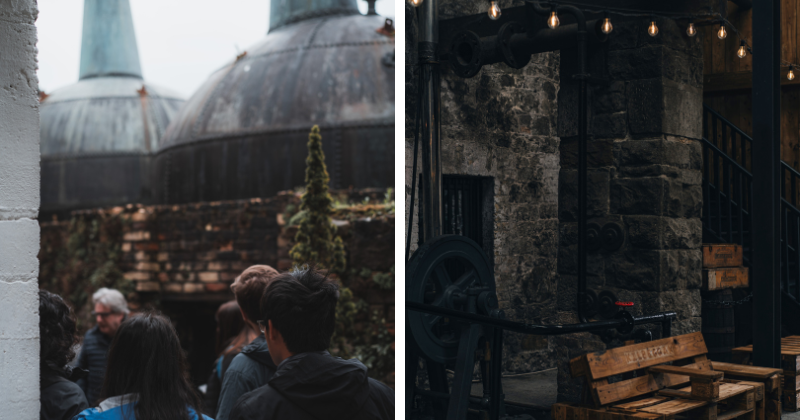
Glendalough and Wicklow Mountains
Ireland is one of those countries where you can leave the city and arrive somewhere nearby and truly wonder... how on earth does this exist so close to the modern world? How can two worlds so vastly different co-exist side-by-side? The Wicklow Mountains are like an oasis in a desert. You leave the bustling city center and within an hour you’re surrounded by sky-soaring peaks looming over slumbering lakes.
Birds sing their little songs from the foliage around you. A little shake of the trees. They’re watching, playing, welcoming you to their home: Ireland’s largest national park. Over 220 square miles of valleys, coastlines, and mountains soaring some 800 meters above you.
If you’re a nature lover, make sure you add this beautiful region to your list. Keep your eyes peeled for feral goats (though ‘feral’ is a loose term... some might say cute), graylag geese, and a myriad of other animals in their nesting grounds among some of Ireland’s tallest and oldest trees.
But animals aren’t all you’ll find hiding among the greenery of this stunning landscape. At the south end of the national park lies the magnificent settlement called Glendalough. It’s one of the most important and ancient monastic sites in Ireland, drawing endless visitors year after year.
This striking early Christian settlement was founded back in the 6th century by Saint Kevin and developed into a ‘Monastic City’. Today, crumbling ruins remain surrounded by the lush wildness of the national park. Walking under the ancient gateway feels like stepping into another world – into a ‘city’ whose grasp remains strong on this world. Admire the 30m high Round Tower, still incredibly well-preserved and good enough for Rapunzel. Wander by the Priest’s House and discover the remains of the granite cross, before admiring the largest church on the site, the ‘Cathedral’ with its nave, chancel, and sacristy.
It’s an easy drive from Dublin, just over one hour, or you can join us there on tour.
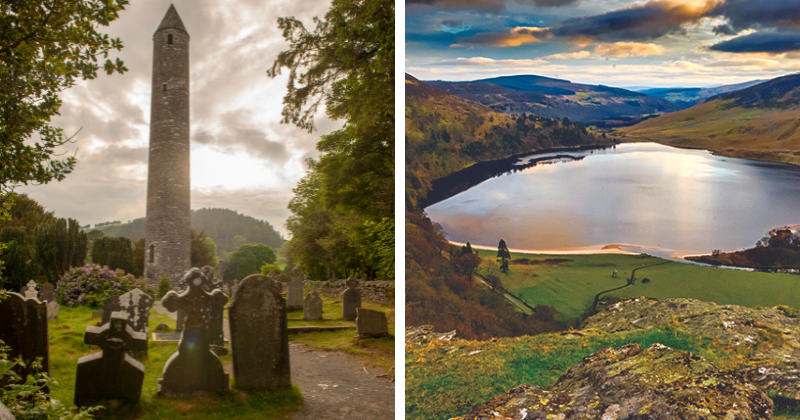
Rock of Dunamase
Have you ever seen the movie The Chronicles of Narnia: the Lion, the Witch, and the Wardrobe? That scene at the end where the epic battle takes place? The classic good versus evil, set among a divinely rugged landscape of rolling green hills and rocky mounds, fairytale creatures running about defending their land?
That’s what I picture when I look at the Rock of Dunamase. Crumbling ruins of a once-magnificent Celtic fortification... what am I saying? It’s still magnificent. I do love a good ruin. With its uninterrupted view of the surrounding Irish countryside for as far as the eye can see, patches of farmland stretch out before you, some light, some dark, some rich with soil, separated by lines of trees and bushes. The view from the Rock of Dunamase has a way of making you feel both small and magnificent at the same time.
Ownership of this castle was passed over again and again through strategic marriages until it was finally destroyed during the Cromwellian invasion in 1650.
Stand among the remnants of history. Gaze out over the view. Imagine what it might have been like to live and fight and die in such a place. Luckily for you, you’re here to simply admire it. It’s just over an hour via car from Dublin or you can jump onboard this Rabbie’s tour.
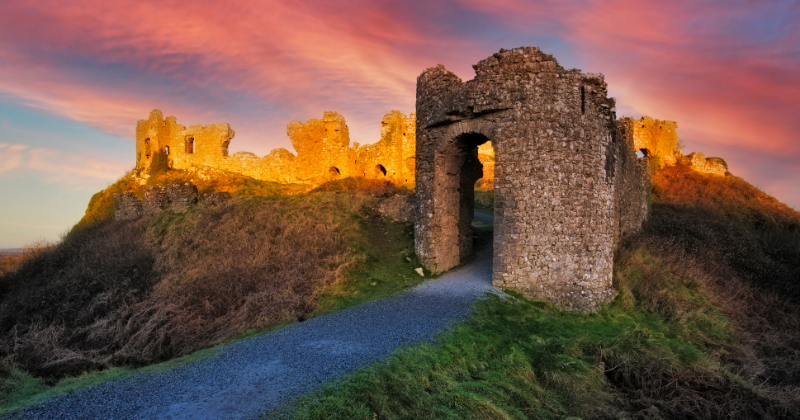
Rock of Cashel
Last but not least, allow me to introduce you to the ‘high king of Irish monuments’, the Rock of Cashel. What is it about Ireland and perching dramatic buildings on top of striking hills with stunning views? I’m here for it.
This outcrop of limestone in the Golden Vale (an area of Ireland dominated by rolling pastureland) holds great historic significance and is the most impressive collection of medieval buildings in Ireland, including a round tower, a high cross, a Romanesque chapel, a Gothic cathedral, an abbey, the Hall of the Vicars Choral, and a fifteenth-century Tower House.
So basically, it’s the ruins of a medieval ‘city’ waiting for you to explore it. And you’d be hard pressed to find anything quite like it in Ireland. Take Cormac’s Chapel, for example, which contains the only surviving Romanesque frescoes in Ireland. And, as you wander this humbling city, you'll surely be as amazed as I was by the sheer enormity of the structures around you.
It was originally the seat for the Kings of Munster (the Kingdom of Munster existed in the south-west of Ireland from around the 1st century BC until 1118), and according to legend, St. Patrick himself visited the Rock of Cashel to convert King Aenghus to Christianity. If it’s good enough for St. Paddy to visit, it’s good enough for us!
It takes about two hours to drive to the Rock of Cashel from Dublin or you can join a Rabbie’s tour.
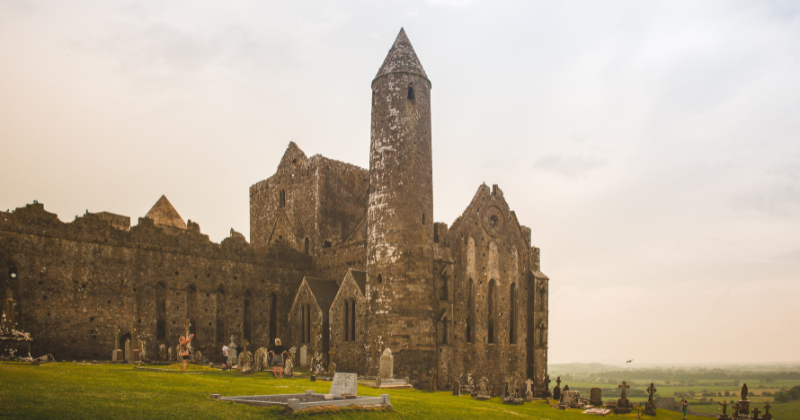
And those are just a few of the incredibly beautiful, striking, and historic places you can see in Ireland. Like many of the landscapes in this part of the world, it’s dotted with historic treasures, almost too many to see. It’s the kind of place where you’ll spot dozens of unusual structures just sitting by the side of the road, or winking at you from a distant rolling hill, mounds and ruins and curiosities – so many you simply can’t stop at them all. But you want to, and I understand the compulsion, trust me.
But for those visiting Ireland – and Dublin in particular – these are a few of my personal must-dos and must-sees that should make their way to your travel bucket list. And, while exploring, if you happen upon something spectacular that you think I’d like, definitely let me know!






